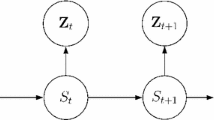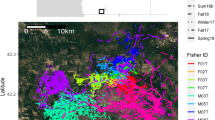Abstract
The use of accelerometers in wildlife tracking provides a fine-scale data source for understanding animal behavior and decision making. Current methods in movement ecology focus on behavior as a driver of movement mechanisms. Our Markov model is a flexible and efficient method for inference related to effects on behavior that considers dependence between current and past behaviors. We applied this model to behavior data from six greater white-fronted geese (Anser albifrons frontalis) during spring migration in mid-continent North America and considered likely drivers of behavior, including habitat, weather and time of day effects. We modeled the transitions between flying, feeding, stationary and walking behavior states using a first-order Bayesian Markov model. We introduced Pólya-Gamma latent variables for automatic sampling of the covariate coefficients from the posterior distribution, and we calculated the odds ratios from the posterior samples. Our model provides a unifying framework for including both acceleration and Global Positioning System data. We found significant differences in behavioral transition rates among habitat types, diurnal behavior and behavioral changes due to weather. Our model provides straightforward inference of behavioral time allocation across used habitats, which is not amenable in activity budget or resource selection frameworks.
Supplementary materials accompanying this paper appear online.




Similar content being viewed by others
References
Albert, J. H. and Chib, S. (1993). “Bayesian analysis of binary and polychotomous response data.” Journal of the American statistical Association, 88(422), 669–679.
Altmann, J. (1974). “Observational study of behavior: Sampling methods.” Behaviour, 49(3-4), 227–266.
Baldassarre, G. A. (2014). Ducks, Geese, and Swans of North America, Vol. 1. JHU Press.
Breed, M. D. and Moore, J. (2015). Animal Behavior. Academic Press.
Broekhuis, F., Grünewälder, S., McNutt, J. W., and Macdonald, D. W. (2014). “Optimal hunting conditions drive circalunar behavior of a diurnal carnivore.” Behavioral Ecology, 25(5), 1268–1275.
Brooks, S. P. and Gelman, A. (1998). “General methods for monitoring convergence of iterative simulations.” Journal of computational and graphical statistics, 7(4), 434–455.
Brown, J. H., Gillooly, J. F., Allen, A. P., Savage, V. M., and West, G. B. (2004). “Toward a metabolic theory of ecology.” Ecology, 85(7), 1771–1789.
Chakravarty, P., Cozzi, G., Ozgul, A., and Aminian, K. (2019). “A novel biomechanical approach for animal behaviour recognition using accelerometers.” Methods in Ecology and Evolution.
Chen, J., Zhu, J., Wang, Z., Zheng, X., and Zhang, B. (2013). “Scalable inference for logistic-normal topic models.” Advances in Neural Information Processing Systems, 2445–2453.
Ely, C. R. (1992). “Time allocation by Greater white-fronted geese: influence of diet, energy reserves and predation.” The Condor, 94(4), 857–870.
Fox, A. D., Glahder, C. M., and Walsh, A. J. (2003). “Spring migration routes and timing of Greenland white-fronted geese-results from satellite telemetry.” Oikos, 103(2), 415–425.
Frühwirth-Schnatter, S. and Frühwirth, R. (2007). “Auxiliary mixture sampling with applications to logistic models.” Computational Statistics & Data Analysis, 51(7), 3509–3528.
Frühwirth-Schnatter, S. and Frühwirth, R. (2010). “Data augmentation and MCMC for binary and multinomial logit models.” Statistical modelling and regression structures, Springer, 111–132.
Gelman, A., Hill, J., and Yajima, M. (2012). “Why we (usually) don’t have to worry about multiple comparisons.” Journal of Research on Educational Effectiveness, 5(2), 189–211.
Gilks, W. R., Richardson, S., and Spiegelhalter, D. (1995). Markov chain Monte Carlo in practice. Chapman and Hall/CRC.
Glynn, C., Tokdar, S. T., Howard, B., Banks, D. L., et al. (2019). “Bayesian analysis of dynamic linear topic models.” Bayesian Analysis, 14(1), 53–80.
Harrison, X. A., Blount, J. D., Inger, R., Norris, D. R., and Bearhop, S. (2011). “Carry-over effects as drivers of fitness differences in animals.” Journal of Animal Ecology, 80(1), 4–18.
Heurich, M., Hilger, A., Küchenhoff, H., Andrén, H., Bufka, L., Krofel, M., Mattisson, J., Odden, J., Persson, J., Rauset, G. R., et al. (2014). “Activity patterns of Eurasian lynx are modulated by light regime and individual traits over a wide latitudinal range.” PLoS One, 9(12), e114143.
Holmes, C. C. and Held, L. (2006). “Bayesian auxiliary variable models for binary and multinomial regression.” Bayesian analysis, 1(1), 145–168.
Holsclaw, T., Greene, A. M., Robertson, A. W., Smyth, P., et al. (2017). “Bayesian nonhomogeneous Markov models via Pólya-Gamma data augmentation with applications to rainfall modeling.” The Annals of Applied Statistics, 11(1), 393–426.
Hooten, M. B. and Hobbs, N. T. (2015). “A guide to Bayesian model selection for ecologists.” Ecological Monographs, 85(1), 3–28.
Hooten, M. B., Johnson, D. S., Hanks, E. M., and Lowry, J. H. (2010). “Agent-based inference for animal movement and selection.” Journal of Agricultural, Biological and Environmental Statistics, 15(4), 523–538.
Hooten, M. B., Johnson, D. S., McClintock, B. T., and Morales, J. M. (2017). Animal Movement: Statistical Models for Telemetry Data. CRC Press.
Hooten, M. B., Scharf, H. R., Hefley, T. J., Pearse, A. T., and Weegman, M. D. (2018). “Animal movement models for migratory individuals and groups.” Methods in Ecology and Evolution, 9(7), 1692–1705.
Johnson, D. S., London, J. M., Lea, M.-A., and Durban, J. W. (2008). “Continuous-time correlated random walk model for animal telemetry data.” Ecology, 89(5), 1208–1215.
Krapu, G. L., Reinecke, K. J., Jorde, D. G., and Simpson, S. G. (1995). “Spring-staging ecology of midcontinent greater white-fronted geese.” The Journal of wildlife management, 736–746.
Leos-Barajas, V., Photopoulou, T., Langrock, R., Patterson, T. A., Watanabe, Y. Y., Murgatroyd, M., and Papastamatiou, Y. P. (2017). “Analysis of animal accelerometer data using hidden Markov models.” Methods in Ecology and Evolution, 8(2), 161–173.
Linderman, S., Johnson, M., and Adams, R. P. (2015). “Dependent multinomial models made easy: Stick-breaking with the Pólya-Gamma augmentation.” Advances in Neural Information Processing Systems, 3456–3464.
McClintock, B. T. (2017). “Incorporating telemetry error into hidden Markov models of animal movement using multiple imputation.” Journal of Agricultural, Biological and Environmental Statistics, 22(3), 249–269.
McClintock, B. T., London, J. M., Cameron, M. F., and Boveng, P. L. (2017). “Bridging the gaps in animal movement: hidden behaviors and ecological relationships revealed by integrated data streams.” Ecosphere, 8(3), e01751.
Michelot, T. and Blackwell, P. G. (2019). “State-switching continuous-time correlated random walks.” Methods in Ecology and Evolution, 10(5), 637–649.
Michelot, T., Langrock, R., Bestley, S., Jonsen, I. D., Photopoulou, T., and Patterson, T. A. (2017). “Estimation and simulation of foraging trips in land-based marine predators.” Ecology, 98(7), 1932–1944.
Morales, J. M., Haydon, D. T., Frair, J., Holsinger, K. E., and Fryxell, J. M. (2004). “Extracting more out of relocation data: building movement models as mixtures of random walks.” Ecology, 85(9), 2436–2445.
Nathan, R., Spiegel, O., Fortmann-Roe, S., Harel, R., Wikelski, M., and Getz, W. M. (2012). “Using tri-axial acceleration data to identify behavioral modes of free-ranging animals: general concepts and tools illustrated for griffon vultures.” Journal of Experimental Biology, 215(6), 986–996.
Patterson, T. A., Parton, A., Langrock, R., Blackwell, P. G., Thomas, L., and King, R. (2017). “Statistical modelling of individual animal movement: an overview of key methods and a discussion of practical challenges.” AStA Advances in Statistical Analysis, 101(4), 399–438.
Polson, N. G., Scott, J. G., and Windle, J. (2013). “Bayesian inference for logistic models using Pólya-Gamma latent variables.” Journal of the American statistical Association, 108(504), 1339–1349.
Resheff, Y. S., Rotics, S., Harel, R., Spiegel, O., and Nathan, R. (2014). “AcceleRater: a web application for supervised learning of behavioral modes from acceleration measurements.” Movement Ecology, 2(1), 27.
Rubin, D. B. (2004). Multiple imputation for nonresponse in surveys, Vol. 81. John Wiley & Sons.
Rugg, D. J. and Buech, R. R. (1990). “Analyzing time budgets with Markov chains.” Biometrics, 1123–1131.
Scharf, H., Hooten, M. B., and Johnson, D. S. (2017). “Imputation approaches for animal movement modeling.” Journal of Agricultural, Biological and Environmental Statistics, 22(3), 335–352.
Sung, M., Soyer, R., and Nhan, N. (2007). “Bayesian analysis of non-homogeneous Markov chains: Application to mental health data.” Statistics in Medicine, 26(15), 3000–3017.
Zucchini, W., MacDonald, I. L., and Langrock, R. (2016). Hidden Markov Models for Time Series: An Introduction using R. Chapman and Hall/CRC.
Author information
Authors and Affiliations
Corresponding author
Additional information
Publisher's Note
Springer Nature remains neutral with regard to jurisdictional claims in published maps and institutional affiliations.
Electronic supplementary material
Below is the link to the electronic supplementary material.
Rights and permissions
About this article
Cite this article
Schafer, T.L.J., Wikle, C.K., VonBank, J.A. et al. A Bayesian Markov Model with Pólya-Gamma Sampling for Estimating Individual Behavior Transition Probabilities from Accelerometer Classifications. JABES 25, 365–382 (2020). https://doi.org/10.1007/s13253-020-00399-y
Received:
Accepted:
Published:
Issue Date:
DOI: https://doi.org/10.1007/s13253-020-00399-y




